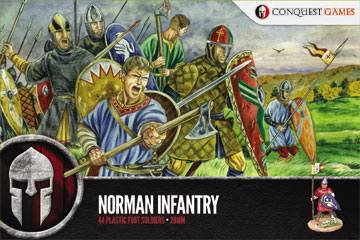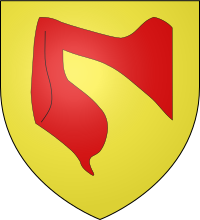All deployed we began the battle. James T was commanding the French once again, with me taking the subsidiary role of French cavalry commander; whilst Paul and James S divided duties for the English.
JT decided to try to do what the French had not on the day, and advance the infantry under cover of the crossbowmen. Recognising that the narrowing of the battlefield would hamper any progress we initially agreed to see what the first line could do, and then elect to try and bring the cavalry through the lines to finish the job if they were not enough. This would require careful traffic management.
The French bring all their crossbows through the lines, whilst the cavalry close up. I elected to play the knights of Vendome and Dammartin as aggressively as possible, and so on the third turn - by which point the French had otherwise advanced but little, and the English not at all - Vendome's right made a charge against Camoy's left, hidden in the trees.
The English bowmen were caught off guard and scattered back into the trees (double one on a break test) never to return. The knights meanwhile were enfiladed by fire from the English wedges and forced to retire with heavy losses. But their success spurred on the left wing who attempted to charge between the stakes and in to the English billmen. They came up short.
The harrying fire into both flanks savaged the charging knights, and they broke in panic. By now The Constable of France was advancing his men at arms, screened by a supported line of crossbowmen.
Failed orders and the narrowing of the gap caused no end of problems for the French, Dammartin at the rear started to organise his men at arms into deeper reinforced lines, with less frontage. Vendome rallied his remaining knights, whose retreat had further disordered French lines. Now the counts crossbows approached shooting range to the English.
From the forest, the men of York watched the advancing mass warily, yet they kept up a steady rate of fire into their lines.
Though in this units' case to virtually no effect, by quirk of the dice, their shooting repeatedly proved devastating to knights and men at arms, but utterly ineffectual to lightly armed troops. It was soon agreed they had only been issued with armour piercing arrows, and when faced with unarmoured troops they did not know what to do!
By now the French were becoming more spread out, but their front line was closing on the English.
the arrow storm was thinning their numbers but not yet stopping the advance. Vendome's rallied knights threw themselves on to the stakes of Camoy's remaining bowmen, as a vanguard of glory for the dismounted men behind.
They pushed the bowmen back from their stakes, but this only allowed the English to gain the support of their infantry, and this broke the exhausted French, sweeping away Vendome with his shattered knights. The French lost some time as a result, but heavily armed men on foot would next take on the English. King Henry remained confident despite the weakening of the defences on his left.
Due to disorder though it was the centre and his right that came under pressure next as the Constable began to exchange shots with his foe, and formed supported lines of men at arms and infantry behind with the aid of Alencon. Half of his crossbows retired in panic from the English, but he was able to keep a screen ahead of his men, and this was proving vital.
Finally Men at arms struck Camoy and Henry simultaneously, Camoy's men being routed in a short brutal attack, when a thousand men at arms came upon them. In the centre Henry had little more than two hundred of his own, but he threw his lot in with them and hope to fight off double their number of Frenchmen in full plate carrying great-swords and staff weapons. Naturally I made Henry a +3 commander, with the attendant risk that held; but this proved vital to this fight, and the impetuous French were repelled with great loss.
There was no time for celebration though, as another two to three thousand French fell upon York's right wing moments later.
The English were forced back from their stakes again, and from the fringes of the wood, this time the weight of numbers favoured the French and the isolated English in the wood soon fled. With his left broken and his right on a knife edge things looked to be all over for Henry. A final coordinated attack now came in from the centre.
Here the wedge formation of the English, behind their stakes, saved the day, but the inability of York's men to support one another gave up the right. Dammartin's cavalry finally had made their presence felt, but the impression they made was slight, a thousand of them being routed in short order, before the second line was sent in to restore some honour.
As a final ignominy, Ysembart and his peasants had occupied the English camp, and began to pillage all within.
At this point it was clear the French were victorious.
But as I had been keeping records, it was in fact closer than the English commanders realised. Both the Constable's and Alencon's divisions were on the very edge of collapse - each needed only one more shaken or destroyed unit to become broken, and given all the attacks they put in were combined attacks from both commands this could easily have happened.
The English scarcely moved all battle, doing no more than using their infantry as a reserve. Whilst the French had much ground to cover. Some infantry inevitable got left behind, as they fell out of command range for divisional orders, and became less crucial to the overall plan. In event JT's decision to lead with the crossbowmen was undoubtedly the correct one, and gave them the best possible chance of victory.
But should it have been that easy?
So far as accurately reflecting the numbers and dispositions of the day, I was happy with the forces, so far as the result, not so sure. There were too many units for the French, resulting in too many targets for the English to try to take down, and they were too disciplined and orderly too.
For balance in any subsequent refight I would do the following:
- Although I would not reduce the numbers of models/men involved. I would turn the French into Large - even Huge units with higher combat values and stamina, but less control. This would give the English fewer targets to consider, and make the French line less mobile.
- Reduce all the French command ratings by one. The English were command 9, but didn't need it. The Constable was also a 9 but Alencon and Vendome were 8's and Dammartin a 7, these allowed for too many successes. As a side note the French commanders were only rated +1 in combat, whilst the English were +2 or +3. As it was only Vendome joined a melee for the French and it didn't change the result.
- Give the French knights and men at arms the Frenzied charge rule, so that they insist on pushing the crossbows all the time, combined with the Eager and Drilled rules this would keep the French advancing and make it so much harder for the lead line to be held back.
- Increase English bow shooting to 4, at long range only. This would add to the affect of the massed plunging fire of volleyed arrows, but at short range the instinct to slower aimed fire will kick in.
These changes I feel would make for a more realistic recreation of the events on the day, without deliberately misrepresenting the numbers of troops involved. As far as the game as played though, all involved enjoyed it immensely, and we drew many favourable comments from the rest of the crowd present on the day.
All told a great success, just not for the English. I envisage on this basis Shakespeare's 'Henry the Fifth' would have involved a final act with him delivering a sad soliloquy from a French dungeon, awaiting the payment of his ransom; conditional on surrendering his claims to the crown of France.
Now that is a very different outcome.
























































